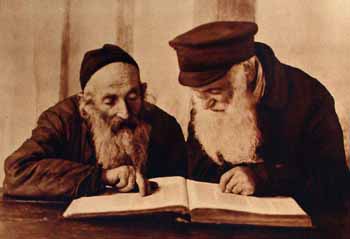Return to Education Newsletter main page! |
Chav’rutah Connections: The History of Paired Learning
By Gabi Cohn, ISJL Education Fellow
Singer-songwriter Jack Johnson sang, “it’s always more fun to share with everyone.” Judaism has a deep seeded history of sharing not just physical resources, but also intellectual property. Rabbis and students in yeshivas, schools for Torah study, have used chav’rutah (partner/learning partner) as a way of studying Torah since the year 10 CE. Chav’rutah is the Aramaic word for “friendship” or “companionship.” In chav’rutah study, two people come together to study text. The difference between chav’rutah study and classroom teaching is the relationship between the people. Rather than a teacher lecturing, chav’rutah encourages both participants to share equally in the teaching and learning. Each person regards the other person in their pair as an equal, and often the pair comprises two people with similar levels of knowledge. Together the students go through a text and break down their understanding. Historically, chav’rutah study was used mainly for studying Tal’mud (study/Talmud/3rd-7th century Jewish legal text) because there are many contradictions and confusing segues within the Talmudic text. However, the educational gains of using chav’rutah learning in the classroom are huge. Teaching someone what you know is one of the best ways to thoroughly learn the material. This educational practice has been proven time and time again throughout history, and can be traced back to as early as the Roman philosopher, Seneca saying, “While we teach, we learn.” Over time, chav’rutah study has become a staple of Jewish teaching. While it is possible to study Jewish texts alone, the Rabbis encouraged chav’rutah study. They argued that without someone to discuss the text with, one would become stupid (Talmud Berakhot, 36b). Learning with another person can create conflict around what a text means, and Judaism thrives off of disagreements over interpretation. The Talmud bursts with disagreements and arguments between Rabbis. One of the most famous continual disagreements is between Shammai and Hillel. They learn together, yet always have different interpretations of laws. On some, they make compromises, on others they agree to disagree, and we tend to follow Hillel’s rulings. However, without the discussion and challenge of views, Judaism would not be where it is now. In today’s religious school classrooms, we may not be doing intensive Talmud study like the Rabbis, but we are still engaging in Jewish study. The practice of chav’rutah study is just as important today as it was at the time of the Rabbis. We can use chav’rutah as a way to engage in a text study, reading a textbook, or simply discussing a prompt. We can begin learning in chav’rutah, and then have a whole class discussion on what we discussed. Or, we can flip it and first have a classroom broader discussion and then break into chav’rutah. The possibilities are endless. Not only has learning through teaching been proven to be successful, but it also stays true to the practices beginning with the start of Rabbinic Judaism. |
- Home
- WHO WE ARE
-
WHAT WE DO
- PODCAST
- Conference >
- Education >
-
CULTURE
>
- Culture Overview
- Cultural Programming >
-
History
>
-
Encyclopedia of Southern Jewish Communities
>
- Alabama Encyclopedia
- Arkansas Encyclopedia
- Georgia Encyclopedia
- Florida Encyclopedia
- Kentucky Encyclopedia
- Louisiana Encyclopedia
- Mississippi Encyclopedia
- North Carolina Encyclopedia
- Oklahoma Encyclopedia
- South Carolina Encyclopedia
- Tennessee Encyclopedia
- Texas Encyclopedia
- Virginia Encyclopedia
- Encyclopedia Credits
- Oral History
-
Encyclopedia of Southern Jewish Communities
>
- SPIRITUALITY >
- DONATE
- Shalom Y'all
- Strategic Plan
- Southern & Jewish Blog
- Calendar
- Virtual Press Kit
|
©2024 Goldring/Woldenberg Institute of Southern Jewish Life
|

